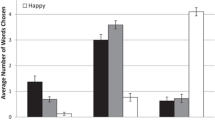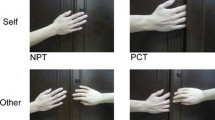Abstract
In general, organisms are motivated to avoid stimuli that induce pain. However, some individuals intentionally inflict pain on themselves (e.g., nonsuicidal self-injury) and report doing so for the perceived emotional benefits following the experience of pain. Two controlled laboratory studies sought to expand upon the relatively limited literature on the effects of pain on emotion. In Study 1, participants provided momentary affect ratings immediately before and after experiencing physical pain. Results demonstrated that both positive affect and negative affect (NA) decreased following the experience of pain. In the Study 2, we examined the effect that individual differences in emotional reactivity had on affective reactions to pain. Individuals high in emotional reactivity experienced larger decreases in NA following the experience of pain than individuals who were low in emotional reactivity. Our findings may potentially explain why some individuals intentionally seek out the experience of pain.

Similar content being viewed by others
References
Aiken, L. S., & West, S. G. (1991). Multiple regression: Testing and interpreting interactions. Thousand Oaks, CA: Sage Publications.
Anestis, M. D., Peterson, C. B., Bardone-Cone, A. M., Klein, M. H., Mitchell, J. E., Crosby, R. D., et al. (2009). Affective liability and impulsivity in a clinical sample of women with bulimia nervosa: The role of affect in severely deregulated behavior. International Journal of Eating Disorders, 42, 259–266.
Brain, K. L., Haines, J., & Williams, C. L. (2002). The psychophysiology of repetitive self-mutilation. Archives of Suicide Research, 6, 199–210.
Chapman, A. L., Gratz, K. L., & Brown, M. Z. (2006). Solving the puzzle of deliberate self-harm: The experiential avoidance model. Behavior Research and Therapy, 44, 371–394.
Eccleston, C., & Crombez, G. (1999). Pain demands attention: A cognitive-affective model of the interruptive function of pain. Psychological Bulletin, 125, 356–366.
Freud, S. (1952). A general introduction to psychoanalysis. New York: Washington Square Press. (Original work published 1920).
Haines, J., Williams, C. L., Brain, K. L., & Wilson, G. V. (1995). The psychophysiology of self-mutilation. Journal of Abnormal Psychology, 104, 471–489.
Heath, N. L., Toste, J. R., Nedecheva, T., & Charlebois, A. (2008). An examination of nonsuicual self-injury among college students. Journal of Mental Health Counseling, 30, 137–156.
Hollin, G. J. S., & Derbyshire, S. W. G. (2009). Cold pressor pain reduces phobic fear but fear does not reduce pain. Journal of Pain, 10, 1058–1064.
Klonsky, E. D. (2009). The function of self-injury in young adults who cut themselves: Clarifying the evidence for affect-regulation. Psychiatry Research, 166, 260–268.
Leknes, S., Brooks, J. C. W., Wiech, K., & Tracey, I. (2008). Pain relief as an opponent process: A psychophysical investigation. European Journal of Neuroscience, 28, 794–801.
Linehan, M. M. (1993). Cognitive-behavioral therapy of borderline personality disorder. New York: Guilford Press.
Mercer, M. E., & Holder, M. D. (1997). Antinociceptive effects of palatable sweet ingesta on human responsivity to pressure pain. Physiology & Behavior, 61, 311–318.
Muehlenkamp, J. J., Engel, S. C., Wadeson, A., Crosby, R. D., Wonderlich, S. A., Simonich, H., et al. (2009). Emotional state preceding and following acts of non-suicidal self-injury in bulimia nervosa patients. Behavior Research and Therapy, 47, 83–87.
Murray, F. S., & Hagan, B. C. (1973). Pain threshold and tolerance of hands and feet. Journal of Comparative and Physiological Psychology, 84, 639–643.
Nock, M. K., & Prinstein, M. J. (2004). A functional approach to the assessment of self-mutilative behavior. Journal of Consulting and Clinical Psychology, 72, 885–890.
Nock, M. K., Wedig, M. M., Holdberg, E. B., & Hooley, J. M. (2008). The emotion reactivity scale: Development, evaluation and relation to self-injurious thoughts and behaviors. Behavior Therapy, 39, 107–116.
Orbach, I., Mikulincer, M., King, R., Cohen, D., & Stein, D. (1997). Thresholds and tolerance of physical pain in suicidal and nonsuicidal adolescents. Journal of Consulting and Clinical Psychology, 65, 646–652.
Pomerleau, O. F., Turk, D. C., & Fertig, J. B. (1984). The effects of cigarette smoking on pain and anxiety. Addictive Behaviors, 9, 265–271.
Rainville, P., Vet Huynh Boa, Q., & Chrentien, P. (2005). Pain-related emotions modulate experimental pain perception and autonomic responses. Pain, 118, 306–318.
Selby, E. A., Anestis, M. D., Bender, T. W., & Joiner, T. E. (2009). An exploration of the emotional cascade model in borderline personality disorder. Journal of Abnormal Psychology, 118, 375–387.
Solomon, R. L. (1980). The opponent-process theory of acquired motivation: The costs of pleasure and the benefits of pain. American Psychologist, 35, 691–712.
Watson, D. (2000). Mood and temperament. New York: Guilford Press.
Watson, D., & Clark, L. A. (1994). The PANAS-X: Manual for the positive and negative affect schedule-expanded form. Iowa City: University of Iowa. Unpublished manuscript.
Watson, D., Clark, L. A., & Tellegen, A. (1988). Development and validation of brief measures of positive and negative affect: The PANAS scales. Journal of Personality and Social Psychology, 54, 1063–1070.
Welch, S. S., Linehan, M. M., Sylvers, P., Chittams, J., & Rizvi, S. L. (2008). Emotional responses to self-injury imagery among adults with borderline personality disorder. Journal of Consulting and Clinical Psychology, 76, 45–51.
Acknowledgments
This research was supported, in part, by a grant from ND EPSCoR to Kathryn H. Gordon (NSF Grant EPS-081442).
Author information
Authors and Affiliations
Corresponding author
Rights and permissions
About this article
Cite this article
Bresin, K., Gordon, K.H., Bender, T.W. et al. No pain, no change: Reductions in prior negative affect following physical pain. Motiv Emot 34, 280–287 (2010). https://doi.org/10.1007/s11031-010-9168-7
Published:
Issue Date:
DOI: https://doi.org/10.1007/s11031-010-9168-7




